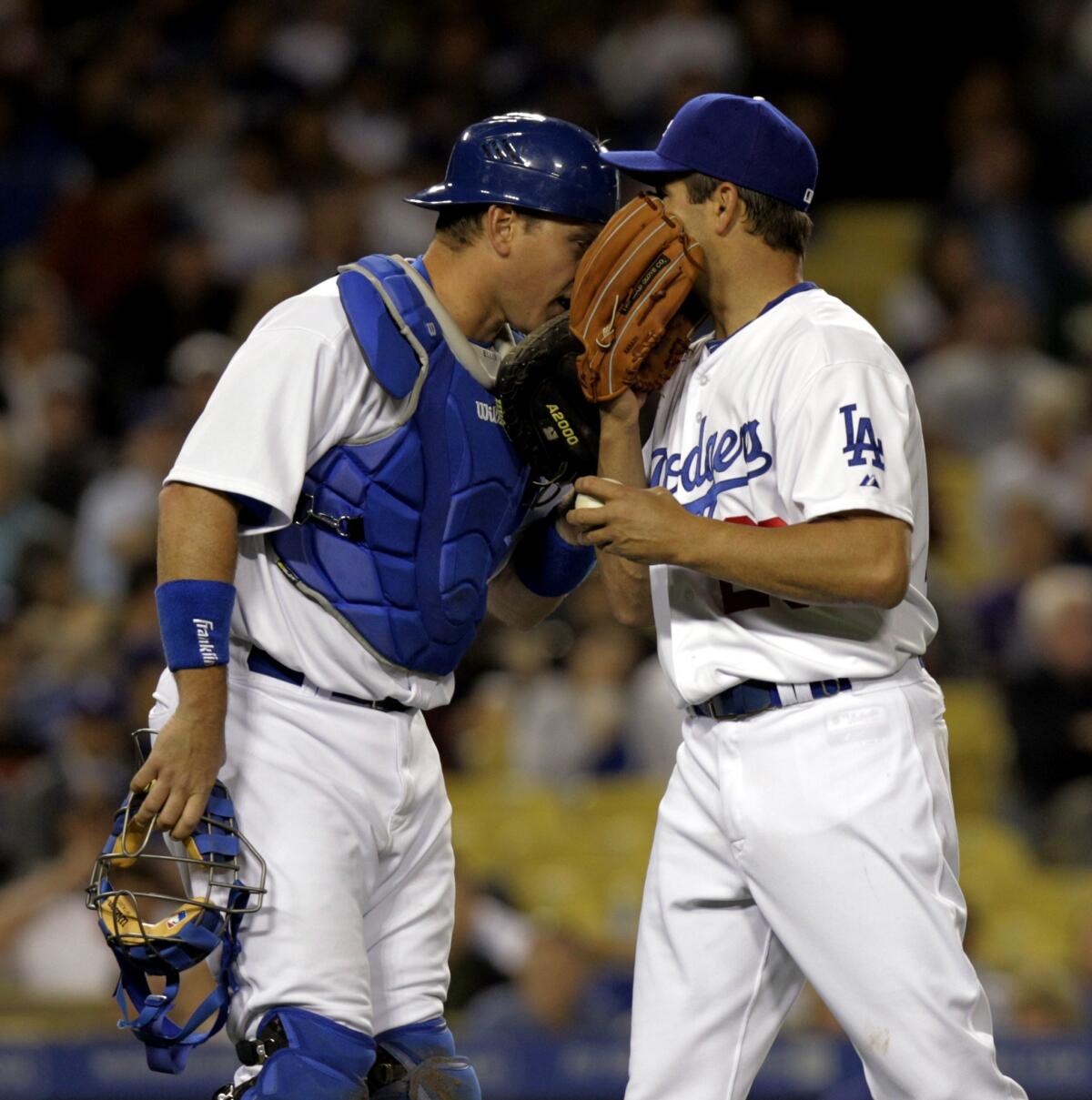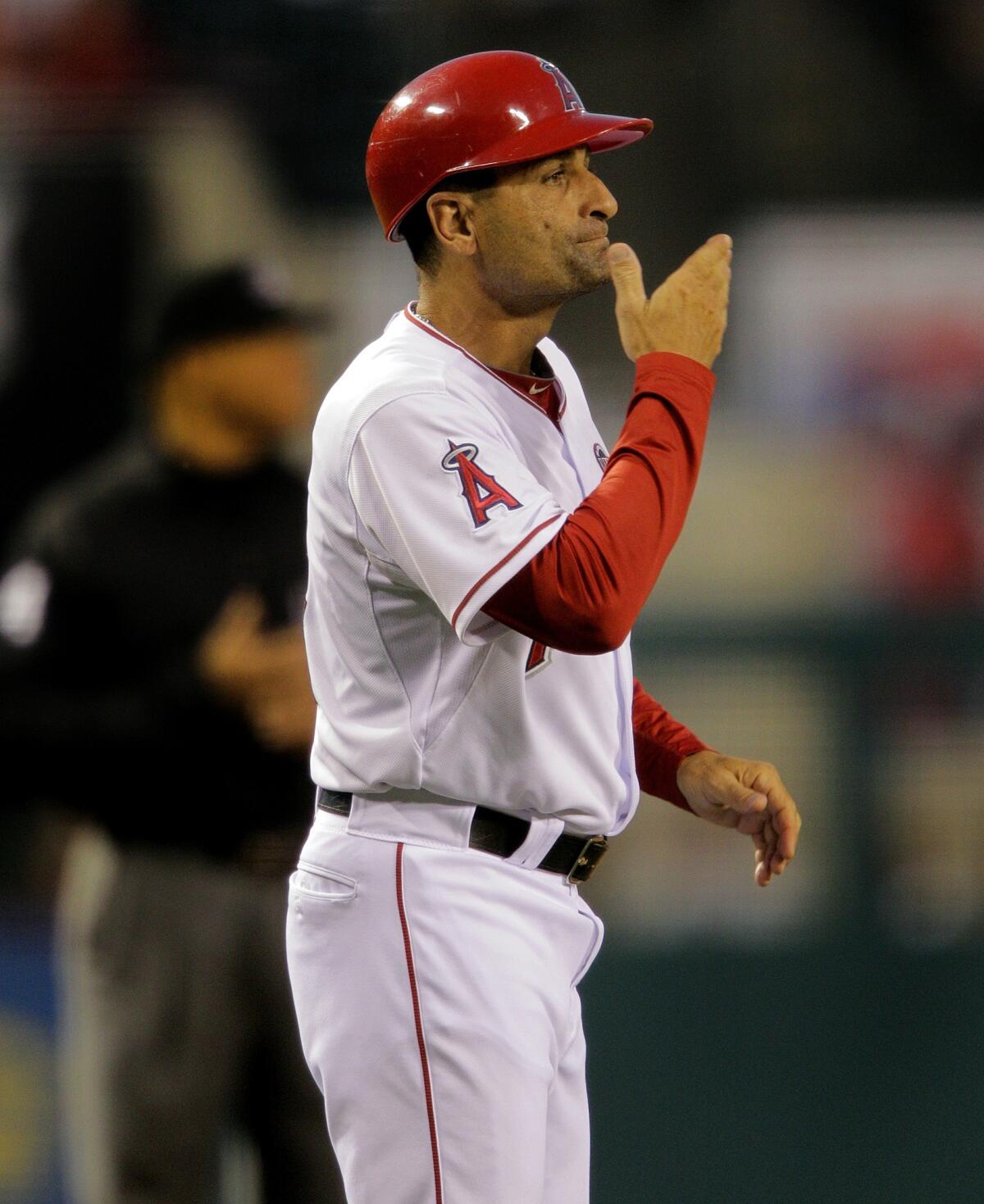Simple gestures mean so much in baseball
Taps, touches, tugs and tips... they carry complex messages among pitchers, batters, coaches and managers. The wordless codes can be raised to an art level, and are protected as if they are state secrets.
- Share via
It's the fourth inning of a tight game at Angel Stadium and Chicago White Sox pitcher Jake Peavy is in a jam. The Angels are threatening to score with runners on first and third bases and one out.
As the right-hander backs off the mound to compose himself, Angels hitter Alberto Callaspo steps out of the batter's box to adjust his helmet and batting gloves.
What looks like a break in the action is anything but. It's part of a wordless game within the game.
In the Angels' dugout, Manager Mike Scioscia taps his nose, the bill of his cap, then his chin in rapid succession. That says it all.
Third base coach Dino Ebel, who has been watching closely, decodes the movements and then starts his own conversation — again without a word. Touching parts of his body in three sequences, he relays directions from Scioscia to Callaspo, and then to each baserunner.
In the Chicago dugout, the White Sox are stealthily putting their own plot into action. Trying to stay a step ahead of what the Angels are doing, a coach shifts the defense by motioning with his hands. By the time the pitcher and catcher settle on a pitch, again communicated with signs, every player on the field will have been told where to go and what to do — all without a single instruction uttered aloud.
Baseball has its own sign language, and complex messages are exchanged in a matter of seconds.
"There's a lot that goes on in the course of a game," says Angels bench coach Rob Picciolo, who advises Scioscia in the dugout. "It sounds complicated, but once you do it every day, you get used to it."


Opponents will try to crack a team's code, so pitchers and catchers change up their signs. Above, Dodgers pitcher Ted Lilly chats with catcher A.J. Ellis in April.
Signs came to baseball from the battlefields of the Civil War, where field generals sought to conceal their plans, according to historian Paul Dickson, author of "The Hidden Language of Baseball."
In one system known as "wig-wag," flags and torches were used to warn Confederate soldiers about the movement of Union troops. Two years later, at West Point, cadets tipped each other to secret inspections by tapping on pipes, and cheated on tests by wiping their lips or winking.
During a typical nine-inning baseball game, there are hundreds of sign sequences, each part of a distinct strategy — telling the runner to steal, the batter not to swing at a pitch, or directing the fielders how to defend against a bunt.
Keeping everyone on the same page is imperative. The infielders need to know where the catcher's throw is going to go if there is a runner at third and a runner at first tries to steal second base; a baserunner looking to steal needs to know whether the batter has been ordered to bunt.
It's all done knowing the opposing team has players and coaches who are trying to crack your code.
A hitter has an advantage if he knows what pitch is coming (curveball, fastball, change-up) and where it's being aimed (high, low, on the inside corners of the strike zone or the outside). Former New York Yankees great Yogi Berra used to try to read the shadows cast by a catcher's fingers. A few teams notoriously used binoculars, telescopes or video cameras from peek holes in the outfield wall.
Years ago, the Detroit Tigers used a spotter tucked away in the scoreboard to read the catcher's signs, which were relayed to the hitter by moving the eyes of a large Indian head mounted on an advertisement.
That's one reason why pitchers and catchers change up their signs. Without a runner on base, their language might be as simple as the catcher flashing one finger for a fastball and two for a curve. But with a runner on second base looking in from the same angle as the pitcher, the signs could be stolen. So they become more complex, possibly involving numbers on the scoreboard or parts of the catcher's equipment.

Angels third base coach Dino Ebel claps his hands toward a batter.
That tap to the shin guards or touch to the protective headgear? It might actually mean something.
"Basically they're anything you can think of," Angels reliever Kevin Jepsen says. "You could come up with one right now and that could be somebody's sign."
To make things even more complicated — and harder for the enemy to decipher — there is a set of signals unique to each pitcher. With the Angels using 21 pitchers already this season, catcher Hank Conger has to learn 21 dialects, and also know the signs from his manager.
"Over the years I may have missed a couple," Conger says, "but I really take pride in trying not to miss a sign."

With Angels batter Callaspo ready to hit and Peavy set to pitch, both managers have set their strategies.
Two runners are on with one out, so Scioscia wants to avoid an inning-ending double play. Howie Kendrick is a fast runner at first base, so a hit-and-run-play is in order. That means Kendrick will take off as the pitch is thrown and the batter will be swinging no matter where the pitch is, trying to hit the ball on the ground.
White Sox Manager Robin Ventura has ordered Peavy to throw to first base between pitches, keeping Kendrick close and making it harder for the Angels to put on the play.
The strategy of both sides may now be exposed. The Angels know the White Sox expect Kendrick to run because they threw over to first. And, if Kendrick flinched toward second at all before scrambling back to first, he may have tipped his hand that he was, indeed, under instructions to run as the pitcher began his windup.

Ebel says it can be a problem if a coach gets caught up in the game's emotion and begins signing too quickly.
So Callaspo backs out yet again and peers at Ebel, the third base coach, who looks into the dugout for a new set of orders, then begins his pantomime. With his right hand, he touches his side and then his thigh; with his left hand, he reaches across his body to touch his right forearm.
Third base coaches are the most visible signers on the field, and they walk a fine line. The signs need to be simple enough for their players to read yet complex enough that the opposition can't crack the code. For example, a coach touching his hand, elbow and shoulder on the left arm might be ordering a bunt, hit and run or steal. But if he makes the same signs on the right arm, that would mean nothing.
Or those signs mean nothing unless an indicator such as a touch to the hat or chin comes first. Similarly, whether a play is on or off can be determined by whether the coach is standing inside or outside the 20-foot-long coach's box.
Players say Jose Oquendo of the St. Louis Cardinals and current Houston Astros Manager Bo Porter are among the best at signing, so fluid that their motions look like interpretive dance moves. Many coaches, including the Dodgers' Tim Wallach, practice their routines in front of a mirror.
"I want to see what it looks like," Wallach says.

He called them dummy signs because our guys were too stupid."— Steve Lyons, former ballplayer
Rhythm can be just as important as repetition, especially in pressure-packed moments when a coach can be caught in the emotion and begin signing too quickly.
"I slow it down," says Ebel, who is in his eighth season with the Angels. "As a third base coach, you recognize it and try to develop that to give it back to the player. Going through it kind of fast speeds up the game."
Each player has his own set of signs for a couple of reasons. If a player is traded, he won't be able to understand the signs of his former teammates. Also, coaches don't want their own players unwittingly tipping the opposing team by reacting on the bench — standing up to see better, motioning to a teammate to pay close attention — when a surprise such as a squeeze bunt or double steal is in the works.
Just as the players take daily batting and fielding practice, they are also quizzed on signs by their coaches.
"If a player misses the sign, it's just like anything else — you haven't spent enough time with that player," Ebel says. "If a guy has to take 100 ground balls a day to get the fielding mechanic down, everybody does that. Why can't you spend 10, 15 minutes every day for that player to understand the system and the signs? It's important."
Some players just never quite seem to catch on, though.
Former ballplayer Steve Lyons, now a member of the Dodgers' broadcast team, said that when he played in Boston, third base coach Rene Lachemann got so fed up with the Red Sox's missing signs that he made a dramatic change: Lachemann would go through an entire series of signals — "He called them dummy signs because our guys were too stupid," Lyons recalls — then clap once for a bunt, twice for a hit-and-run and three times for a steal.

Ebel says being a third base coach is like being a player. "You have good games, you have bad games."
"Hey, those are our signs," jokes Dodgers Manager Don Mattingly, having overheard Lyons' story. "Now we're going to have to change them."

Back in Anaheim, the game of cat and mouse continues. Ebel signals to Callaspo and Kendrick that the hit and run is off, and the batter lets Peavy's 3-1 pitch go, drawing a walk. The next batter, Chris Iannetta, walks as well, forcing in the winning run in an Angels victory.
Few Angels in uniform have played a bigger part in the win than Ebel, who dresses quickly and leaves without fanfare.
"Being a third base coach, it's like being a player," says Angels bench coach Picciolo, who was a third base coach for three seasons with the San Diego Padres. "You have good games, you have bad games. You feel like you have a lot to do with the account of the game."
Go beyond the scoreboard
Get the latest on L.A.'s teams in the daily Sports Report newsletter.
You may occasionally receive promotional content from the Los Angeles Times.










